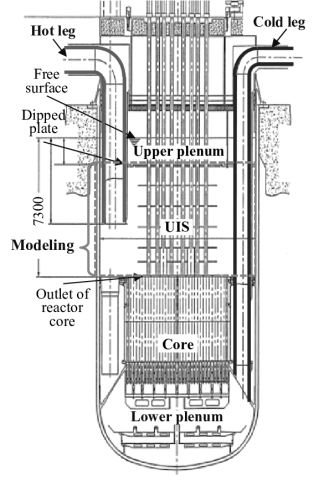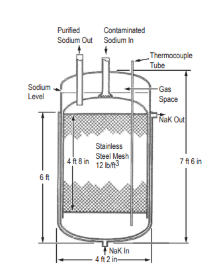This project entails the design of a purification system for molten sodium coolant in a sodium-cooled fast reactor (SFR). The AFR-100 design from Argonne National Laboratory was used as the basis for the system. The purification system is comprised of a combination of both hot and cold traps placed in the core assembly and primary loop of the reactor. The cold trap design was chosen from a previously-used cold trap in a sodium-cooled reactor. The decision matrix is based on design parameters chosen based on the reactor, with an emphasis on trap efficiency. The hot trap is a new design created by the group, with each component chosen to maximize the efficiency of the trap.
Team: Alex Vest, Eric Lowden, Megan Kowalewski, Chris Howes
Project Advisors: Dr. Yunfeng Shi and Dr. Jie Lian

Members of the design group
Project Motivation
Breeder reactors provide several advantages over traditional reactors, such as breeding new fuel during operation and producing waste radionuclides with shorter half lives than radionuclides of reactors currently in use. Additionally, breeder reactors are often safer compared to conventional reactors as breeder reactors use molten salt or molten metals as coolants (as opposed to water, which thermalizes neutrons at a much higher rate), which leads to the reactor having better thermal properties for mitigating possible core overheating during accidents. However, using these molten moderators has some drawbacks. Radionuclides, corrosion products, and other impurities produced in the core can build in the coolant loop and cause blockages and other damage to the reactor, which are potentially catastrophic. To prevent this, the reactor must have some form of purification system.

Grandy, C. et al. (2014). "Advanced Fast Reactor 100 (AFR-100) Report for the Technical Review Panel." Argonne National Laboratory. publications.anl.gov/anlpubs/2014/08/79118.pdf
Project Description
This project entails the design of a purification system for molten sodium coolant in a sodium-cooled fast reactor (SFR). The AFR-100 design from Argonne National Laboratory was used as the basis for the system. The purification system is comprised of a combination of both hot and cold traps placed in the core assembly and primary loop of the reactor. The cold trap design was chosen from a previously-used cold trap in a sodium-cooled reactor. The decision matrix is based on design parameters chosen based on the reactor, with an emphasis on trap efficiency. The hot trap is a new design created by the group, with each component chosen to maximize the efficiency of the trap.

Wolfe, T. et al.(2012). "Development and Analysis of Cold Trap for use in Fission Surface Power-Primary Test Circuit." ntrs.nasa.gov/archive/nasa/casi.ntrs.nasa.gov/20120003157.pdf
Results and Accomplishments
The project saw the modification of an existing cold trap design, the FSP-PTC design, to better suit the specifications of the AFR-100 reactor design.The first design area for the hot trap was selecting the materials, where it was determined that graphite and zirconium iodide would be the best media for the removal of radionuclides and corrosion products from the coolant stream respectively. Next, it was found that the best design for removing the impurities was a ratio of 1 layer of 4 nm thick graphene for every 9 layers of 32 μm thick zirconium oxide. Finally, analysis of the pressure drop in the reactor was used as the limiting factor for optimizing the length of the hot traps for two different locations. The final designs for the hot traps were a 13.9 cm diameter trap with a maximum length of 52.21 cm in the primary hot sodium and a 50 cm diameter trap with a maximum length of 8.375 cm in the core inlet channel.